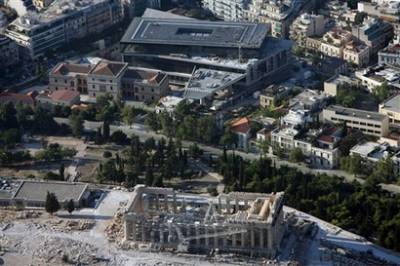 |
|
|
Greece to Open Acropolis Museum in June; Will Contain Over 4,000 Ancient Works |
|
ATHENS, Greece – The long-awaited museum where Greece hopes to one day display the Elgin Marbles alongside other ancient masterpieces from the Acropolis will be inaugurated this summer. Culture Minister Antonis Samaras said Friday the opening ceremony will be held on June 20. Initially, Greece had planned to open the New Acropolis Museum ahead of the 2004 Athens Olympics. Crouching at the foot of the Acropolis, the new glass and concrete museum is the centerpiece of Greece's campaign for the return of the Elgin — or Parthenon — Marbles from the British Museum in London. |
 |
| The British Museum has repeatedly refused to relinquish the 2,500-year-old sculptures, which formed part of the Parthenon Temple's decoration until Scottish diplomat Lord Elgin removed them to Britain 200 years ago. At the time, Greece was still an unwilling part of the Ottoman Empire. The British Museum argues that it legally acquired the Marbles, which form an integral part of its collection and are easily accessible to visitors from all over the world. But Greek officials say the 129 million-euro ($166 million) new building will allow all the surviving Parthenon sculptures to be displayed together — with the 5th century B.C. temple appearing as a backdrop through glass walls. Samaras provided no details on the opening ceremony, but in light of the global economic downturn, Greece has scrapped earlier plans for a ?6 million ($7.7 million) extravaganza. "We are cutting spending where we can," Samaras said. Designed by U.S.-based architect Bernard Tschumi in collaboration with Greece's Michalis Photiadis, the new museum will contain more than 4,000 ancient works in 215,000 square feet (20,000 square meters) of display space. The project has been dogged by repeated delays and criticized for its size and proximity to the Acropolis — a U.N. world heritage site. Construction work disrupted an entire neighborhood of ancient and early Christian Athens, prompting legal wrangling. Many of these ruins have been incorporated in the museum basement and are visible through glass panels. A delicate operation to lift hundreds of statues from an old museum on the Acropolis using cranes was completed in early 2008, prompting officials to promise an opening that September. But the final exhibition blueprint was only approved this week. The Parthenon was built between 447-432 B.C., at the height of ancient Athens' glory, in honor of Athena, the city's patron goddess. It survived virtually intact until a massive explosion caused by a Venetian cannon shot in 1687, when the Parthenon was being used a gunpowder warehouse by a Turkish garrison. |
|
|
(Posting date 29 April 2009) HCS encourages readers to view other articles and releases in our permanent, extensive archives at the URL http://www.helleniccomserve.com/contents.html. |
|
|
|
|
2000 © Hellenic Communication Service, L.L.C. All Rights Reserved.
http://www.HellenicComServe.com |
|
